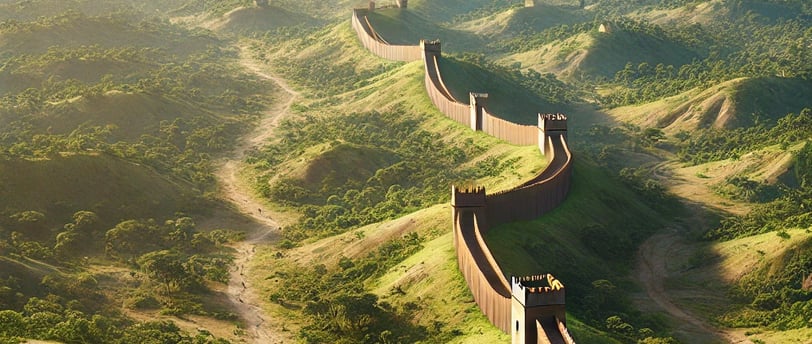Unveiling Africa's Myths: A Journey Through History and Heritage
Discover the Great Wall of Benin, an edifice second only in sheer size to the Great Wall of China, that you have never heard of!
11/29/20242 min read


The Great Wall of Benin
The Great Wall of Benin, also known as the Walls of Benin, is a monumental achievement of African engineering and urban planning. Built to protect and define the great Benin Kingdom, these walls represent one of the most extensive earthworks in human history, showcasing the ingenuity and organizational prowess of pre-colonial African societies.
The Great Wall of Benin was a vast complex of defensive walls and moats surrounding the city of Benin (modern-day Benin City) and its surrounding settlements. The walls comprised both inner city walls and an extensive network of outer walls, forming a combination of earthworks and ditches. The walls were constructed with packed earth and clay, reinforced by a surrounding moat known locally as the Iyá. The ditches were dug by hand, creating an imposing barrier to invaders.
The walls were constructed by the people of the Benin Kingdom under the leadership of successive Obas (kings), particularly during the height of the kingdom’s power between the 13th and 15th centuries. Construction required the coordination of thousands of workers, reflecting the kingdom's advanced societal organisation and labour management.
The walls protected the city and surrounding settlements from external threats, including rival kingdoms and invasions. The inner walls defined the boundaries of Benin City and arranged the layout of the kingdom’s capital.
The walls represented the strength, wealth, and authority of the Oba and the kingdom as a whole, creating an unmistakable impression of dominance.
A Feat of Engineering and Urban Planning
The Walls of Benin stretched an estimated 16,000 kilometres, enclosing approximately 6,500 square kilometres, making them the largest earthworks ever constructed prior to the mechanical era. Built entirely with manual labour, the walls and ditches were engineered to be functional and monumental. Parts of the walls stood for centuries as a physical and cultural barrier.
Why It Matters
At just 5000km shorter than the Great Wall of China, the Great Wall of Benin was once considered the world’s largest earthwork structure by total volume. Early European explorers who documented its grandeur admired it because the walls are entirely a testament to the advanced engineering capabilities and strategic urban planning of the Benin Kingdom. challenging colonial-era misconceptions about Africa’s past.
The Great Wall of Benin stands as a monumental reminder of the brilliance of the Benin Kingdom, one of Africa’s most influential and advanced pre-colonial civilizations. Its vast scale, architectural complexity, and historical significance emphasize Africa’s contributions to global history. Exploring the remnants of the walls offers a glimpse into a society's ingenuity, organisation, and power that left an indelible mark on the continent’s heritage.
Comparison: While the Great Wall of China is longer overall, the Great Wall of Benin covers more enclosed areas and represents the largest single earthwork system in history.
Culture
Unearthing Africa’s myths, history, and stories together.
Legends
Heritage
© 2024. All rights reserved.
© Chinenye Egbuna Ikwuemesi 2025.
All rights reserved.
The Afrodeities Codex and all associated titles, stories, characters, and mythologies are the intellectual property of the author. Unauthorized use is strictly prohibited.
